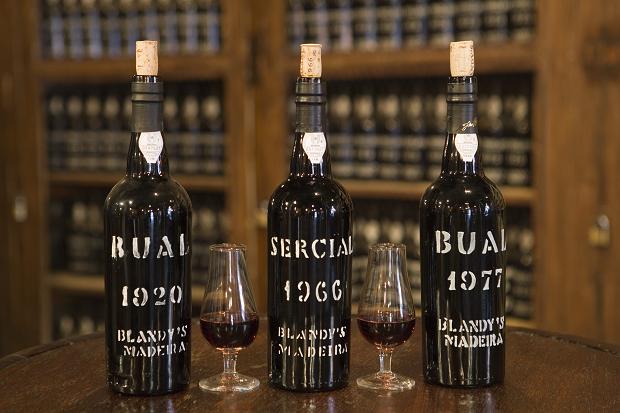
Before we get into the historical aspects of Madeira, can you explain what exactly it is and how best to drink it?
[Madeira] is a fortified wine. [Fortification] is the process of adding a clear distillate, usually un-aged brandy, to not only fortify the strength of the wine but also to halt fermentation leaving not only residual sugar but also an environment not suited for other microorganisms to survive. This helps prevent spoilage.
The wine is usually around 19-20% ABV. Small glasses are preferred and it should generally be served at room temperature, although chilling the more acidic styles can be pleasant. These wines can exhibit a world of complex flavors. Everything from citrus, nuttiness, caramel, soft vanilla notes, smoke, dried fruits, dark sugars, maple syrup etc.
So, the beverage itself is made across the ocean, but Charleston played an important role in the knowledge about and the consumption of Madeira in the United States. Why is that?
Charleston has always been an active port city in North America. Charleston still has reminders of that blossoming (literally) around the city in the form of flowers and spices to this day. Madeira is a wine that is exposed to both heat and oxygen. Famously this happened on the trans-Atlantic ocean voyages. The heat, non-air tight barrels, and rocking motion of the ship would produce a very interesting wine. Heat and oxygen are generally considered to be the two worst enemies of wine. However, exposing the wine to this treatment, over time, not only gave it a very desirable and peculiar flavor, it also made it virtually indestructible to that same heat and oxygen.
Related: The Best of Charleston, South Carolina
Once it got to our shores, who was drinking Madeira?
Madeira was all the rage in colonial America. Many of the upper class citizens viewed wine as the drink of enlightenment and refinement as opposed to distilled spirits. This stayed in place until the Civil War. Madeira was a wine that could survive the journey here in good shape. In fact, some Madeiras would be sent around the world on trips to “Madeirize,” and sometimes the name of the ship would grace the labels of the wine after it was bottled.
I keep mentioning the heat and oxygen thing. If you think about the low country of Charleston, no one really has a cellar that can maintain a low temperature for proper wine storage. We are at sea level, so you really can’t go down much. Barrels of Madeira could be aged in the attics of sweltering Southern homes and actually improve with age. Bottles of Madeira from the 18th century are still good to this day, if you can find them. I recently had a Malmsey from 1908. It’s fascinating to think about what was going on and who was alive when that vintage was growing—1908 still sported Czars and Kaisers.
Can Madeira be made in the United States or are the name, location, and beverage tied together?
Madeira is a protected appellation and has to be made there. Also, I can’t imagine why someone would try to make it here. Even on the younger end of Madeira production you are typically looking at 5 years in a barrel minimum, while the more expensive Frasquieras have to be aged a minimum of 20 years in a barrel. That means that if you aren’t already making them, you have a considerable period of time to get an operation like that started.
In addition, Madeira has been out of fashion for a while now—like post-American Civil War a while.
Finally, Madeira is a tiny place too. For some of the grape varietals, the amount of ground under vine for some is remarkably small. Some of the grape varietals don’t even produce every year. It’s a difficult wine to make and it takes a long time and a very unique process to make.
While it may not be the most popular beverage, these days, it is having a revival of sorts as more people are learning about it through events, reading about it, et cetera. Is there a specific type of Madeira that’s found most often today in Charleston and is there a reason for that?
This is an interesting question. I would imagine that historically all sorts of Madeira would have found their way here, especially for your wealthy collector types. Now, that said, I don’t have any specific sources of info to back up that statement, but it seems completely logical. The Rare Wine Co. has a line of Historic Madeiras that are blended to mimic the styles that were preferred based on cities that dotted the Atlantic coast. As you go north towards Boston and New York the richer, sweeter styles appeal to a cooler climate. To juxtapose those, Savannah and Charleston preferred the dryer styles that are higher in acidity. If you hit up local restaurants here for Madeira you will find the Charleston Sercial bottling often.
When in Charleston, where are the best places to find Madeira?
Today, The Charleston Grill, McCrady’s, Husk, and Edmund’s Oast are great places to seek out Maderia wines. The Charleston Grill has a Madeira flight of old vintage wines. Rick Rubel (the Sommelier at Charleston Grill), tries to keep something around 100 years old on that flight. McCrady’s usually has the entire Historic series available by the glass as well as vintage dated wines. Edmund’s Oast also will have some of the Rare Wine Co. bottlings along with vintage dated wines. One of the pluses for this wine is that it really doesn’t change much after you open it. You could have an open bottle around for years!
(Image: Madeira wine at the Old Blandy Wine Lodge, Funchal, Madeira, Portugal Holger Leue/Getty Images)




